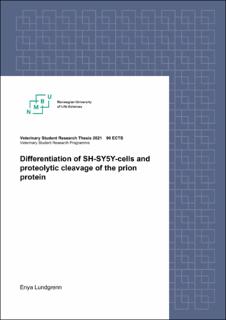| dc.contributor.advisor | Tranulis, Michael A. | |
| dc.contributor.advisor | Bakkebø, Maren K. | |
| dc.contributor.author | Lundgrenn, Enya | |
| dc.date.accessioned | 2023-08-17T11:49:46Z | |
| dc.date.available | 2023-08-17T11:49:46Z | |
| dc.date.issued | 2021 | |
| dc.identifier.uri | https://hdl.handle.net/11250/3084585 | |
| dc.description.abstract | This study focuses on the prion protein (PrPC) and its processing in the cell and physiological functions. The study’s main goal is to contribute to the knowledge of what role PrPC plays in the cells.
We have investigated PrPCs expression in the neuroblastoma cell line SH-SY5Y. We have successfully differentiated these cells into neuron-like SH-SY5Y-diff cells that are more homogenous and probably a better model for adult neuron cells, using a combination of Retinoic Acid, Brain Derived Neurotrophic Factor (BDNF) and serum deprivation. We experimented with different concentrations of BDNF and serum to find optimal differentiation conditions.
PrPC can be proteolytically processed after translation in several ways, the most common being α-cleavage of the protein, resulting into two fragments; C1 and N1. Our main finding concerns the expression of PrPC and the changes in proteolytic cleavage after differentiation as well as the effect of the immunostimulant Poly I:C on differentiated SH-SY5Y cells.
Our results imply that differentiation may alter the PrPC expression both directly through translation and through the proteolytic cleavage of the protein, altering the C1 proportion of the proteolytic fragments in differentiated cells. We have also found that exposure to Poly I:C does not seem to alter the expression of PrPC nor the C1-proportion in differentiated cells, but the differentiated cells had a weaker response to Poly I:C within the measured timeframe of 24 hours.
The experiments are pilot studies, and the results are to be regarded as preliminary. The statistical strength is limited by the low number of replicates. The nature of the cell clones with a highly variable expression of PrPC themselves complicate the interpretation, and especially the mRNA-results are challenging to interpret due to the highly variable mRNA values between cell clones.
Difficulties with the differentiation consumed valuable time at the start of the project and made it challenging to replicate the experiments sufficiently in our given timeframe, as well as proceed with other follow-up experiments.
Further replicates would be needed to clarify if the results were statistically significant or not. It would also be interesting to work with other cell types, for example cells from the Norwegian dairy goats with the PRNP Ter/Ter genotype that are naturally devoid of PrPC.
To conclude, this study has contributed with new information about differentiation of the SHSY5Y cell line. Our data suggest that these cells have higher levels of the C1-fragment of PrPC, indicating alterations in the posttranslational proteolytic α-cleavage. The cells did not seem to respond differently to the immunostimulant Poly I:C when differentiated in regards to PrPC expression. | en_US |
| dc.description.abstract | Denne studien tar for seg prionproteinet (PrPC) og dens prosessering i cellen og fysiologiske funksjoner. Studiens hovedmål er å bidra til kunnskap om hvilken rolle PrPC spiller i cellene.
Vi har sett på PrPCs ekspresjon i neuroblastomcellelinjen SH-SY5Y. Vi har differensiert disse cellene til nevronlignende celler kalt SH-SY5Y-diff som er mer homogene og sannsynligvis en bedre modell for modne nevroner. For å differensiere dem brukte vi en kombinasjon av retinolsyre, hjernederivert neurotrofisk faktor (BDNF) og serumsulting. Vi prøvde oss frem med flere ulike konsentrasjoner av BDNF og serum for å finne den optimale differensieringsprotokollen.
PrPC kan bli prosessert proteolytisk på flere måter etter translasjonen, men den vanligste er den såkalte α-kløyvingen som resulterer i to fragmenter kalt C1 og N1. Vårt hovedfunn angår prosesseringen av PrPC og endringene i proteolytisk prosessering etter differensiering, i tillegg til effekten av immunstimulanten Poly I:C på differensierte SH-SY5Y-celler.
Resultatene våre indikerer at differensiering kan muligens øke PrPCs ekspresjon enten direkte via translasjon og/eller ved øking av C1-andelen av fragmentene via proteolytisk prosessering. Vi har også funnet at stimuli med Poly I:C ikke ser ut til å endre ekspresjonen av PrPC eller C1-andelen i differensierte celler, men at de differensierte cellene hadde en svakere respons til Poly I:C innen 24 timer.
Disse eksperimentene er pilotstudier, og resultatene må derfor ses på som midlertidige. Den statistiske styrken begrenses av det lave antallet replikater. Variasjonen i PrPC- og mRNAekspresjonen mellom celleklonene kompliserer også tolkningen av resultatene.
For å kunne si om studiene er statistisk signifikante trengs flere replikater. Det ville også vært interessant å utforske andre celletyper, for eksempel celler fra norsk melkegeit som har en naturlig forekommende mutasjon, PRNP Ter/Ter som gjør at de ikke uttrykker PrPC.
For å konkludere har denne studien gitt oss ny informasjon om differensiering av cellelinjen SH-SY5Y. Vi har også indikasjoner på at disse modne cellene har høyere nivåer av C1- fragmentet av PrPC, som kan indikere endringer i den posttranslasjonelle proteolytiske α-kløyvingen. De differensierte cellene ser ikke ut til ha endringer i PrPC-ekspresjonen når stimulert med Poly I:C. | en_US |
| dc.language.iso | eng | en_US |
| dc.publisher | Norwegian University of Life Sciences, Ås | en_US |
| dc.rights | Attribution-NonCommercial-NoDerivatives 4.0 Internasjonal | * |
| dc.rights.uri | http://creativecommons.org/licenses/by-nc-nd/4.0/deed.no | * |
| dc.title | Differentiation of SH-SY5Y-cells and proteolytic cleavage of the prion protein | en_US |
| dc.type | Student paper, others | en_US |
| dc.description.localcode | VET-FORSK | en_US |

